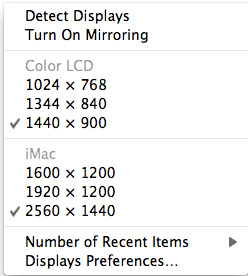Promise Pegasus R6 & Mac Thunderbolt Review
by Anand Lal Shimpi on July 8, 2011 2:01 AM ESTTarget Display Mode with an iMac
In our 2011 iMac review I mentioned that you could use the new iMac as an external display if, and only if, you had a Thunderbolt cable connecting it to a 2011 MacBook Pro. When I reviewed the iMac, you couldn't buy a Thunderbolt cable. Now you can.
The process is pretty simple. Just connect any 2011 MacBook Pro to any 2011 iMac via a Thunderbolt cable. Hit Cmd + F2 on the iMac's keyboard and boom, your brand new iMac is now a secondary display for your MacBook Pro. Note that you need a modern Apple keyboard for this to work. Older Apple keyboards and some non-Apple keyboards won't send the right key code and will refuse to activate target display mode on the iMac.
 |
 |
The iMac has to be fully powered on when this happens. You do lose all keyboard/mouse support on the iMac, however the machine doesn't go to sleep when in this mode - it'll remain on, although likely in a low power state. Any applications you have open on the iMac will remain open. Any music playing on the iMac will continue to play and you don't get use of the iMac's speakers from your MacBook Pro.

15-inch MacBook Pro (2011) + 27-inch iMac (2011) running in Target Display Mode
For 2011, this is admittedly an odd usage model. I'm not sure how many people want to connect their brand new MacBook Pro to a brand new iMac and use the latter as just a display. Down the road I can see this being a good feature as it lets you upgrade to faster MacBook Pros and still use your iMac as a larger display if you'd like.

I would prefer it if the iMac allowed itself to boot into a minimal environment where only the display and necessary ICs were powered, leaving the CPU, GPU, hard drive and the rest of the system mostly powered down. I suspect Thunderbolt complicates this as the controller needs a number of components powered up before it'll function. Perhaps future versions of the iMac can find a way around this limitation however.










88 Comments
View All Comments
Conner_36 - Friday, July 8, 2011 - link
Or even in the office, to able to take your entire project and move between the rooms carrying ALL of the data? That's unheard of!From what I understand with HD movie editing I/O is the bottleneck.
All we need now is an SVN hardware device with thunderbolt to sync across multiple thunderbolt RAIDs. Once thats out you could have a production studio with some real mobile capabilities.
Exodite - Friday, July 8, 2011 - link
I wager pretty much any usage scenario can come up with a high-performance 12TB storage solution for significantly less than 2000 USD.You're right though, it's definitely not the solution for me.
Or anyone I know, or am likely to ever know. *shrug*
Zandros - Friday, July 8, 2011 - link
What happens if you try the Macbook Pro -> Pegasus -> iMac in Target Display Mode -> Cinema Display connection chain?Focher - Saturday, July 9, 2011 - link
Pretty sure the DP monitor has to be the last device in the chain. Maybe that is just a current limitation because there are no Thunderbolt displays.Zandros - Monday, July 11, 2011 - link
AFAICT, the iMac is a Thunderbolt display, since it does not support Target Display Mode from Display Port sources with Display Port cables.tipoo - Friday, July 8, 2011 - link
Is there a way to make it shut off the drives after idling for a while?piroroadkill - Friday, July 8, 2011 - link
But when you saw the file creation maxed out at 9TB, on 10TB array..Since.. uh, Snow Leopard, Apple changed file and drive sizes to display decimal bytes as used by the manufacturers, which is the same as the 10TB array.
However every other thing ever reports in binary bytes, such as windows describing "gigabytes" even though it means gibibytes in reality.
Ugh, anyway, what I'm trying to get at is that maybe you did infact fill the array. That said, the thing shouldn't have fucked up..
CharonPDX - Friday, July 8, 2011 - link
If I had way too much money, my usage model for Target Display Mode would be to use the iMac as a Virtual Machine host/server, connected to either a second iMac or a MacBook Pro as a dual-screen workstation.With the minimum 27" iMac, you're basically buying a 27" Cinema Display plus a $700 Mac mini-on-steroids. If you want a second Apple display for your iMac or MacBook Pro, and want a Mac Mini to use as a server, that is an excellent value to instead just get a second iMac. (That value may drop depending on the next Mac Mini update, of course.)
etamin - Friday, July 8, 2011 - link
in the block diagram on the first page, why is the Thunderbolt Controller connected to the PCH thru PCIe rather than to the processor? I thought PCIe connections came off the processor/NB?repoman27 - Sunday, July 10, 2011 - link
The lanes that come off the processor/NB are usually used for dGPU. On the new MacBook Pros, Apple borrowed four of them for the Thunderbolt controller. Apparently on the new iMacs, however, they decided to give all 16 lanes from the CPU to the graphics card and pulled four from the PCH instead.